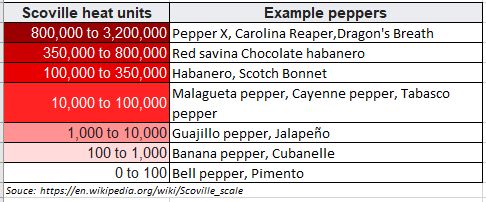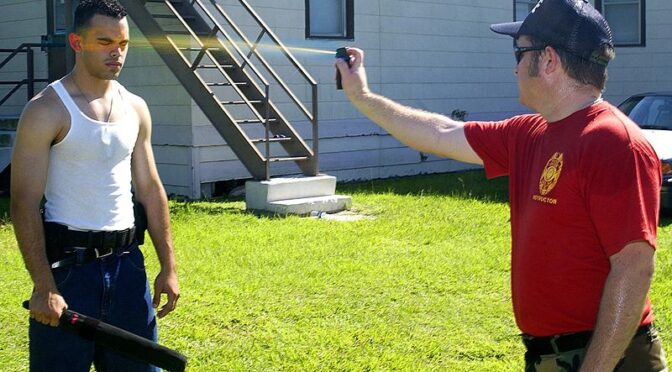| Up front, please let me stress that this post if for informational purposes only. The author will not be liable if you decide to attempt to make or use pepper spray. You assume all liability going forward. Please abide by all laws and regulations in your area – it is illegal to possess pepper spray in some places let alone use it. Last but not least, please follow safe practices if you choose to attempt making pepper spray. |
Pepper spray irritates the eyes, lungs and skin. The intent is to cause extreme temporary discomfort and allow the defender a chance to get away or the police officer to more easily restrain a subject. The reason I researched and wrote this post is that a number of people are worried about personal and family safety and how to ward off attackers given the craziness with people panicking over COVID-19.
For one reason or another, not everyone can buy a firearm and. thanks to government regulation, many law abiding citizens can’t even purchase pepper spray. Now, machining a firearm and its costs are beyond many but making pepper spray is something people might want to consider but there are a whole lot of potential issues I want you to think through before you make some home brew and pour it in a spray bottle.
What is pepper spray anyways?
As you can guess from the name, the main ingredient is technically known as oleresin capsicum (OC) is derived from peppers. OC is an oily organic resin obtained from finely ground chili powder where the capsaicin of the pepper is removed using an alcohol – typically ispropyl or ethanol. The capsaicin is most concentrated in the parts of the pepper that hold the seeds and the rest of the pepper to a lesser extent.
- Wikipedia info about capsaicin
- Wikipedia info on pepper spray
- Drug bank info on capsicum oleoresin
- Medical News Today – What is pepper spray and why is it dangerous?
The following video does a great job explaining how pepper spray affects the human body and how it is made:
How do you make a pepper spray?
| Do not rub your eyes and be careful breathing any airborne powders or liquids. I’d recommend wearing nitrile gloves, eye protection and a dust mask – even a basic nuisance dust one. Please abide by all laws and regulations in your area and follow safe practices if you choose to attempt making pepper spray. |
Let me tell you up front that I am not incredibly impressed by anything I have read or watched. Do you research and be very, very careful.
The “heat” of pepper varieties is measured by the Scoville Heat Units (SHU). The SHU value of a given pepper is measuring the concentration of capsaicinoids, which is premoninantly capsaicin – the part of the pepper we need. So, the higher the Scoville rating, the hotter the pepper is and the stronger the pepper spray will be.

Note – Focus on the peppers not some of the weird home brews folks are making where they are adding in other ingredients because they seem to be irritants based on their own past experience – for example, people adding salt, black pepper and even curry.
Going back to peppers, bear in mind that commercial pepper sprays range from 2-5.3 million SHU. Just because you think Cayenne pepper (30-50,000 SHU) or a Jalapeno (2,500-8,000 SHU) is hot does not mean it is adequate. You need to be thinking about the hottest peppers you can find and using them. Let me give you specifics of the 10 hottest peppers
| Safety comment – you do need to realize pepper sprays made by the hot peppers over 80,000 SHU are dangerous and may cause permanent damage to eyes, etc. You better not spray this hot stuff on anyone without real good cause and be extra careful working with them! |

With the god awful hot peppers, I have no idea how you can safely test your concoction. Honestly, at some point of capsaicin concentration, you are going to cause chemical burns. If you are trying to make liquid hell, you have some very dangerous stuff going on. Please don’t test it on other people, pets, animals, etc.
First extraction video
This gentleman does a good job showing you how to extract the the capsaicin that we need. Note, he uses acetone but I’d recommend an alcohol as it is less volatile and doesn’t dissolve anywhere near as many varieties of plastics as acetone does. There’s solid guidance other than that.
Video Two – The author makes and tests his pepper spray
This fellow both made his own pepper spray and then tests it while reporting the results. Notice how he points out the delay — keep that in mind.
Some mistakes I noticed during my research
When you look around on Youtube and reading blog posts, there are a lot of fundamental mistakes that people make that I want you to be aware of:
- Your goal is to make a concentrate – start with the hottest pepper you can find
- You need to extract the capsaicin so grind up the pepper – don’t just add flakes.
- Focus on the pepper!! Folks adding in other stuff may sound cool but I am not convinced curry powder, salt, black pepper, etc. will help. One fellow even added in a pain killer (lidocain) for reasons I can’t begin to fathom.
- Use a ton of powder/ground pepper. You want to make a concentrate and not something really diluted. Now is not the time to go cheap.
- Use alcohol and not acetone unless you know your plastic can handle it – many household/cheap plastics can’t.
- Allow the alcohol time to dissolve the capsaicins from the peppers. Use a sealed container and give it at least 12 hours to a day while shaking or stirring periodically. A sealed container makes the most sense to me unless you want the solvent to evaporate off and make a concentrate, which is a legitimate consideration.
- You definitely need to strain the resulting mixture. Any type of sprayer will be at risk of clogging if there are solids in the liquid. The folks with a stew of materials floating around in their dispensers are at risk of a clog just when they need the spray the most. I was really surprised at the number of authors who had dispensers with solid remnants floating around.
- Nobody seems to know how long this stuff will last – 3 months might be a starting assumption. It’s not indefinite.
Delivery mechanism considerations
I’ve seen everything from squeeze bottles, to squirt guns to home made single shot stream sprayers. Consider the following:
- whatever you select needs to be leak proof or you will have an awful mess.
- You don’t want it accidentally going off in your purse or pocket … or you will have an awful mess.
- If you do a charged can of some type – ensure the propellant doesn’t slowly leak out and/or have a means to recharge it. Even commercial units will slowly lose their propellant charge.
- Remember to strain the liquid you’re going to use or floating solids will likely clog up your device — and probably when you need the spray the most. Seriously, it blew my mind how few did this.
- You need to test to see how far the liquid can travel. In general you want a stream and not a fog both to concentrate delivery plus you do not want the person near you! Also, bear in mind that a mist will float around and land on others – potentially even yourself.
More resources
- https://www.wikihow.com/Make-Pepper-Spray
- https://thepreppingguide.com/how-to-make-homemade-pepper-spray/
- http://survival-mastery.com/diy/useful-tools/homemade-pepper-spray.html
- https://www.survivopedia.com/how-to-make-pepper-spray-for-self-defense/
- https://www.offgridbliss.com/home-made-pepper-spray/
How to treat pepper spray / how to decontaminate
Okay folks, the following is so you know what to do if you get this stuff on you. The short answer is saline, non-mint antacid in distilled water in a 50/50 mix placed in a squeeze bottle to neutralize the chemical or some form of water and mild soap.
- https://www.frontlinewellness.org/guidelines-for-treating-pepperspraychemical-irritants
- https://www.pepper-spray-store.com/pages/antitdote
- https://www.firehouse.com/rescue/article/10513700/decontamination-training-with-oc-pepper-spray
- https://home.howstuffworks.com/home-improvement/household-safety/pepper-spray4.htm
- https://www.ncbi.nlm.nih.gov/pmc/articles/PMC5851502/
- https://poison.vcu.edu/media/va-poison-center/docs/factsheets/PepperSprays-Clothingdecontamination.pdf
This is not magic or the movies – Beware
Reality is not like the movies – especially with home grown pepper sprays. Expect attackers to respond differently to pepper spray.. Some will immediately lose visibility and the will to fight, some may have a delay before the react and some will keep fighting no matter what due to drugs or whatever. Do not expect an attacker to magically drop to the ground.
The best way to win a fight is avoid the situation – don’t walk alone, avoid dark allies, stay alert, and so forth. View this stuff as a last resort or part of a layered defense that you have thought about.
Conclusion
Someone casually making pepper spray without a lot of thought put into it will likely have very mixed unsafe unreliable results. I didn’t find one video or blog post that I felt addressed my concerns for reliability so I collected the above for you to consider. If you can buy commercial pepper spray, I would highly recommend you do so.
The information presented here is for people who need protection and home-made pepper spray might be their last option. Do your research, plan and build with safety in mind. Last comment, don’t rely solely on pepper spray – consider other things like loud personal alarms, clubs, saps, fake money clips, take a self-defense class, etc.
| Again, please, please be safe if you make anything discussed here. Also, be aware of any laws and regulations that are applicable. In some locales, pepper spray is treated virtually the same as a firearm and civilian use is strictly prohibited. |
If you find this post useful, please share the link on Facebook, with your friends, etc. Your support is much appreciated and if you have any feedback, please email me at in**@*********ps.com. Please note that for links to other websites, I may be paid via an affiliate program such as Avantlink, Impact, Amazon and eBay.
